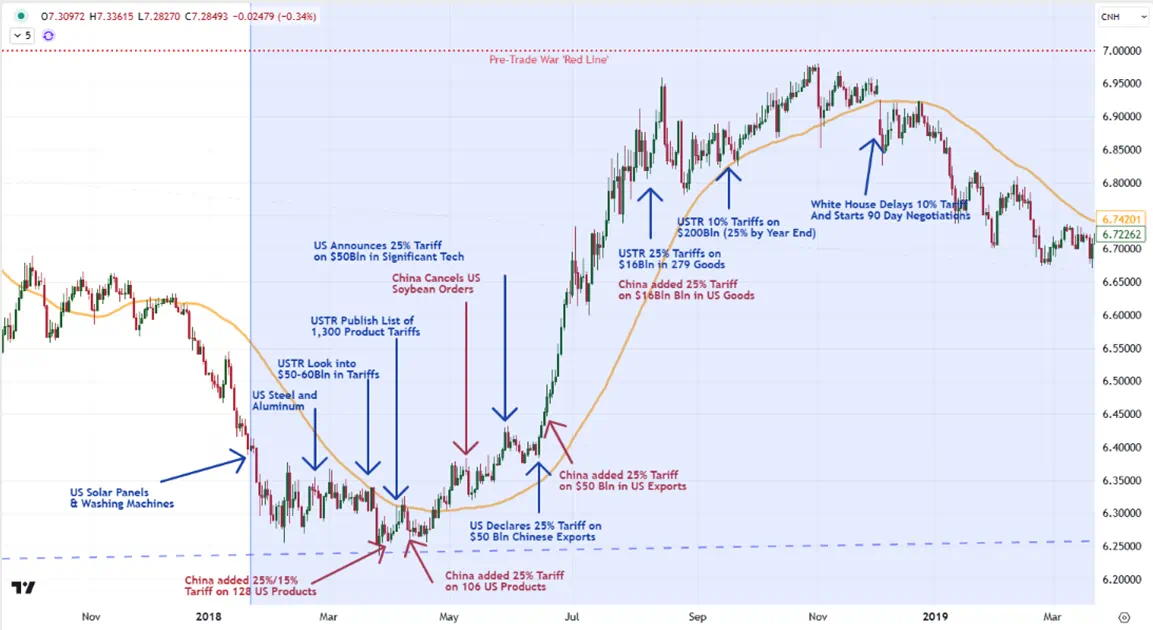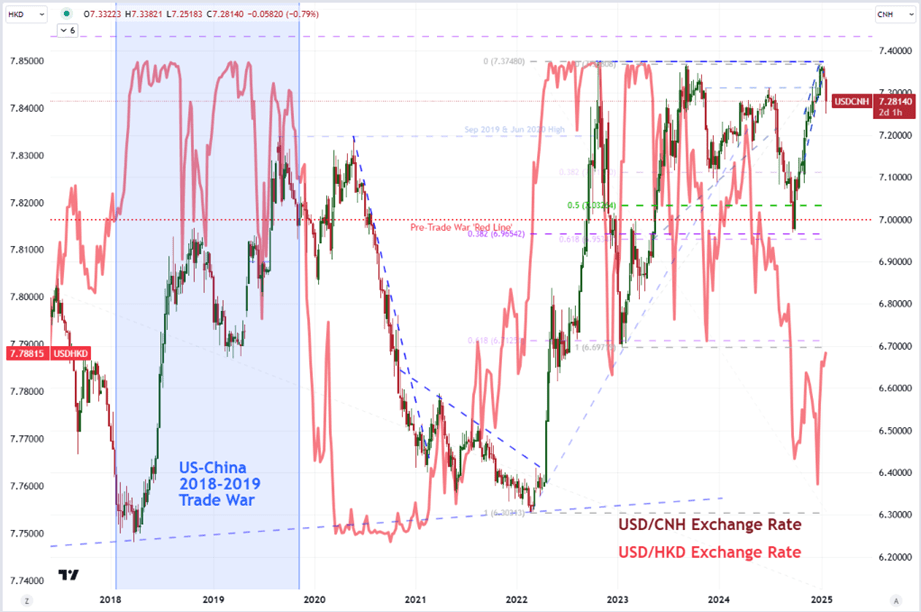During US President Donald Trump’s first term in the White House (January 2017 through January 2021), there were a range of economic and financially divisive policies pursued that meaningfully diverged from his predecessors’ initiatives. Among the most potent global macro policies employed in that four-year term was the application of hefty tariffs against key trade partners aimed at addressing perceived inequity in global trade practices.
In particular, China would engage in a ‘trade war’ of retaliatory tariffs with the United States over a period that cause significant uncertainty in the markets.
What is a trade war?
A trade war occurs when countries impose tariffs or other trade barriers on each other in response to economic or political disputes. These can include import tariffs, export restrictions and other protectionist policies to shelter domestic industries from foreign competition. Trade wars can result in higher costs for businesses and consumers, disrupt supply chains and slow down global economic growth.
How do trade wars affect the economy?
Trade wars affect the economy in many ways:
- Higher costs: higher tariffs mean higher costs for imported goods, higher prices for consumers and businesses.
- Disrupted supply chains: companies that rely on global supply chains may struggle to source materials or find alternatives, resulting in delays and higher production costs.
- Less trade: countries imposing tariffs will see a reduction in both imports and exports, slower economic growth.
- Market volatility: trade conflicts create uncertainty in financial markets, stock prices, currencies and commodities.
- Economic slowdowns: if prolonged trade wars can lead to economic slowdowns, reduced consumer spending and lower business investment.
What triggered the US-China trade war?
The US-China trade war started in 2018 when President Donald Trump imposed tariffs on Chinese imports citing unfair trade practices, forced technology transfer and national security concerns. The Trump administration accused the Chinese government of intellectual property theft, currency manipulation and providing unfair subsidies to Chinese companies. The conflict escalated as both countries imposed tariffs on hundreds of billions of dollars’ worth of each other’s goods.
Key events that escalated the trade conflict:
- January 2018: the US imposed tariffs on solar panels and washing machines.
- March 2018: additional tariffs on steel and aluminum imports raised.
- April 2018: China retaliated with tariffs on 128 US products, including agricultural machinery and auto imports.
- June 2018: the Trump administration tariffs expanded to $50 billion of Chinese exports.
- July 2018: China retaliated with tariffs on an equal amount of US goods, targeting key industries such as crude oil, liquefied natural gas and medical equipment. The tit-for-tat continued through 2018 and into 2019 affecting many industries and markets.
What is the US trade deficit with China?
The US has historically had a large trade deficit with China meaning it imports more from China than it exports. In 2018 the US deficit with China was around $419 billion. President Trump argued this was due to unfair trade practices and wanted to reduce it through new tariffs and export controls.
What would happen if China stopped trading with the US?
If China stopped trading with the US, the impact would be severe for both economies and the global market:
- US companies would suffer: many American companies, especially in technology and manufacturing, rely on Chinese suppliers for production.
- Higher consumer prices: the US imports cheap Chinese goods, including electronics, clothing and household products. A sudden stop in trade would drive up costs for US consumers.
- China’s economy would slow: the US is one of China’s largest export markets and overall exports accounted for approximately 20% of Chinese GDP in 2024 according to China’s National Bureau of Statistics. China’s GDP growth would slow and Chinese companies that rely on American buyers would face financial difficulties.
- Global trade disruptions: other economies, including Canada, Mexico and the European Union, would feel the ripple effects of supply chain disruptions.
Which markets were most affected by the US-China trade war?
Several markets were affected:
1. Foreign Exchange Markets (USD/CNH & USD/HKD)
The trade war had a big impact on currency markets, especially the USD/CNH (offshore yuan) and USD/HKD (Hong Kong dollar) exchange rates.
Source: TradingView, StoneX
As shown in the chart, the USD/CNH exchange rate surged during the peak of the trade war reflecting market uncertainty and capital outflows from China.
Source: TradingView, StoneX
As a special administrative region of China, Hong Kong also experiences heavy influence in trade between the US and China. As such, the Hong Kong dollar also moved substantially in its band with the Dollar during periods of high trade tensions and tariffs from both sides.
2. Equity Markets
- US and Chinese stock markets saw increased volatility, Chinese stocks underperformed due to economic uncertainty and reduced foreign investment.
- US companies exposed to China, such as Apple (NASDAQ:AAPL), Boeing (NYSE:BA) and semiconductor companies, saw stock declines due to export controls and supply chain disruptions.
3. Agricultural Commodities
- China retaliated by imposing tariffs on US agricultural products, particularly soybeans, pork and corn.
- The decline in US soybean exports forced farmers to find alternative markets, with some government aid to offset losses.
4. Technology and manufacturing sectors
- US tech companies like Huawei and ZTE were directly impacted by export controls and national security reasons.
- Supply chains for American and Chinese tech firms were disrupted, affecting global production.
The Phase One Deal
In January 2020 the Phase One deal was signed, a partial resolution to the conflict. Key points:
- China would buy more US goods by $200 billion over two years.
- US would delay tariff increases and reduce some existing tariffs.
- China would address intellectual property and currency concerns.
- Tariffs would remain on hundreds of billions of dollars of goods, leaving uncertainty on a full resolution.
Summary
The US-China trade war of 2018 was one of the biggest trade conflicts in recent history. Driven by unfair trade practices, national security concerns and economic imbalances it led to higher tariffs, supply chain disruptions and market volatility.
The Phase One deal brought some relief, but the bigger trade issues, technology and global economic influence continue to shape US-China relations and international trade policies. Future negotiations and economic shifts will determine if the tensions persist or evolve into new trade agreements.
